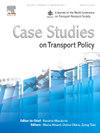A GIS-MCDA spatial classification model to support group decision-making in traffic crash risk management
IF 2.4
Q3 TRANSPORTATION
引用次数: 0
Abstract
The global incidence of fatalities resulting from road crashes, particularly in Brazil, is a matter of great concern. Public managers need to employ efficient measures to decrease these figures. A multicriteria model of geographic support for group decision-making is proposed in this context. The model considers the preferences of many decision-makers involved in traffic management in a medium-sized city in northeastern Brazil. A methodology was presented for simplifying the categorization of routes for each decision maker and the integration of individual outcomes into a collective outcome. Considering the viewpoint of each decision maker, it was suggested that the city’s roads be categorized based on the level of risk they present for the occurrence of traffic crashes using the PROMSORT multicriteria approach. The ultimate categorization was established by considering five distinct categories that indicate different degrees of route importance. The results were geographically represented using a Geographic Information System. Employing the framework may accurately identify the city’s most susceptible regions and allocate resources and risk reduction initiatives with greater efficiency. Therefore, it is possible to obtain valuable information that can assist municipal managers in creating more efficient strategies to improve road safety.
GIS-MCDA空间分类模型支持交通碰撞风险管理群体决策
全球,尤其是巴西,道路交通事故造成的死亡人数众多,令人深感忧虑。公共管理者需要采取有效措施来降低这些数字。在此背景下,我们提出了一个群体决策地理支持多标准模型。该模型考虑了巴西东北部一个中等城市中参与交通管理的众多决策者的偏好。提出了一种方法来简化每个决策者的路线分类,并将个人结果整合为集体结果。考虑到每位决策者的观点,建议采用 PROMSORT 多标准方法,根据道路发生交通事故的风险程度对城市道路进行分类。最终的分类是通过考虑五个不同的类别来确定的,这五个类别表示不同程度的道路重要性。使用地理信息系统对结果进行了地理表示。采用该框架可准确确定城市最易受影响的区域,并以更高的效率分配资源和降低风险措施。因此,有可能获得有价值的信息,帮助市政管理人员制定更有效的战略来改善道路安全。
本文章由计算机程序翻译,如有差异,请以英文原文为准。
求助全文
约1分钟内获得全文
求助全文

 求助内容:
求助内容: 应助结果提醒方式:
应助结果提醒方式:


